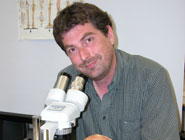Research revealing the first fossil evidence that modern humans left Africa between 65,000 and 25,000 years has been named at No 8 in Time magazine’s Top 10 Scientific Discoveries of 2007. The work was carried out by an international team of scientists, including Dr Alistair Pike of Bristol University.
The scientists determined the age of a skull unearthed near Hofmeyr, South Africa in 1952. They calculated that it was about 36,000 years old and matched skulls found in Europe, eastern Asia and Australia, in age and appearance, which supports the theory that modern man originated in sub-Saharan Africa and fanned out from there.
The project was a collaboration led by Stony Brook University in the US with the universities of Bristol, Oxford, Cape Town, Montreal and the Max Planck Institute in Leipzig.
Initial study of the skull shape showed it to have archaic features, but these were closer to the earliest humans in Europe than the local people. This was particularly interesting because although the predominant theory has modern humans evolving in Africa more than 100,000 years ago, experts are unsure of the origin of the first humans that arrived in Europe 40,000 years ago.
Dr Pike of Bristol’s Department of Archaeology and Anthropology said: “Clearly, determining the age of the skull was extremely important, and I was part of a team that was asked to try to date the skull. This proved very difficult, and we practically had to invent a new dating method to achieve it.”
Experts at Oxford University use a technique called luminescence dating that can date the time since quartz grains (for example, sand) was last exposed to sunlight. This technique is dependent on knowing how much radiation the quartz has been exposed to.
On normal archaeological sites this can be achieved simply from on-site measurements using a device called a spectrometer. However, in this case the quartz grains were inside a skull that had been in a museum for more than 50 years.
Dr Pike continued: “Bone is a particular problem because it can concentrate radioactive uranium over long periods of time and therefore change the radiation the skull would be emitting. I have been studying uranium in bone for a number of years because the radioactive decay of uranium to thorium can be used to calculate a date directly for a bone so I was invited to work with the team in Oxford to help determine the radiation dose for the quartz and hence the age of the skull.”
The problem required a whole series of new approaches. The researchers at Oxford had to produce a 3D scan of the skull so the radiation emitted by the bone and the surrounding sediments could be calculated precisely. They also had to take into account the water content of the sediment which can absorb radiation, the formation of calcium carbonate minerals in the skull after it was buried and account for the uptake of uranium by the bone.
The result was a very complex model of the changing radiation dose the quartz would receive over time. This model yielded an age of 36,000, plus or minus 3000 years, for the skull – almost contemporary with the time modern humans first arrived in Europe.
This was a particularly significant discovery because it provided a chronologically credible link between humans in sub-Saharan Africa and Europe and showed that Europe was probably first populated by modern humans deriving from an African population.
The results of the project were published earlier this year in Science.
